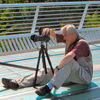RAW vs JEPG
Dec 20, 2013 14:00:20 #
Thombar wrote:
Is there a recommended book/video that will teach us how to shoot and process RAW? Thanks for any suggestions.
There are numerous youtube videos that you can watch for free. Just search for Adobe RAW. Sure some are better than others, but once you find the good ones, it's well worth the time.
--Bob
Dec 20, 2013 14:08:56 #
Thanks Alan, but I don't have/use Lightroom. Can only afford the GIMP at this stage of my learning curve.
Dec 20, 2013 14:10:32 #
alandg46 wrote:
Shooting in jpg's is like shooting film, developing at a one hour kiosk, and throwing the negatives away.
This is absolutely false!
Dec 20, 2013 14:11:42 #
Thombar wrote:
Thanks Alan, but I don't have/use Lightroom. Can only afford the GIMP at this stage of my learning curve.
What camera do you use? Someone here might be familiar with the raw software that comes with it.
Dec 20, 2013 14:12:10 #
Kuzano wrote:
So let me see if I understand you. You edit jpgs and then throw the original jpeg away....?
Why don't you save the new edited jpeg with another name and still keep the old jpeg as your negative?
I don't get it?
Why don't you save the new edited jpeg with another name and still keep the old jpeg as your negative?
I don't get it?
Sure you can keep your old jpg. The discipline is the make sure you copy your original and write protect it so you can't revise it accidentally. Once you change a jpg, it's changed for good. Thus the reason for saving the copy.
With RAW processing, the adjustments are saved in a sidecar file, which the software uses to load the modified image into the editing software. The original RAW file is not changed during this process.
So likening modifying a jpg to destroying your original negative, or slide, is quite accurate.
--Bob
Dec 20, 2013 15:50:18 #
Kuzano wrote:
So let me see if I understand you. You edit jpgs and then throw the original jpeg away....?
Why don't you save the new edited jpeg with another name and still keep the old jpeg as your negative?
I don't get it?
Why don't you save the new edited jpeg with another name and still keep the old jpeg as your negative?
I don't get it?
I shoot RAW only. I edit them and make jpg's for my web site, Facebook, e-mail, whatever.
I was trying to say that shooting jpg's in your camera is akin to taking film pictures, on Velvia or Kodak Professional film. Having them developed and printed as 4x6's on your nearest one hour photo joint then throwing the negatives away.
Dec 20, 2013 16:16:06 #
I'm using a Canon T3 and have the included software. Just have never shot in raw so I'm trying to learn how.
Dec 20, 2013 16:48:09 #
So likening modifying a jpg to destroying your original negative, or slide, is quite accurate.
--Bob[/quote]
Sorry, I don't understand your reasoning. I shoot personal pictures in JPEG format. After perusing and selecting ones I want to work on, I open them in Photoshop. The first thing I do is make a duplicate copy and put in a different folder. I then make adjustments to the duplicate copies and store all the originals in a separate folder and put the folder into a separate back-up hard drive. At anytime, I can pull up the folders and select the pictures again. How is that like throwing the negatives away?
--Bob[/quote]
Sorry, I don't understand your reasoning. I shoot personal pictures in JPEG format. After perusing and selecting ones I want to work on, I open them in Photoshop. The first thing I do is make a duplicate copy and put in a different folder. I then make adjustments to the duplicate copies and store all the originals in a separate folder and put the folder into a separate back-up hard drive. At anytime, I can pull up the folders and select the pictures again. How is that like throwing the negatives away?
Dec 20, 2013 18:41:47 #
johneccles wrote:
Hi Roland, that was a very good response, you can affect the time spent processing RAW down to a very short time once you have learnt how to do it.
I check 5 processes, Exposure,Lighting,Shadows,Clarity and Sharpness. I do not always change all of them unless it's needed, but I always increase clarity and sharpness by a minimum amount. This can take upto a minute or so before going on to editing.
Cheers
John
I check 5 processes, Exposure,Lighting,Shadows,Clarity and Sharpness. I do not always change all of them unless it's needed, but I always increase clarity and sharpness by a minimum amount. This can take upto a minute or so before going on to editing.
Cheers
John
Your comment brings up another thought. People seem to wonder why we always need to sharpen our digital photos, the answer is simple really. With film, all the light is captured on a single layer of silver, on the digital sensor however, each color is on a different layer, and though not too far apart, it's enough to introduce a slight amount of blur to the image. Therefore the need for some sharpening to get a truly tack sharp image.
Dec 20, 2013 18:49:19 #
wilikioti wrote:
The first thing I do is make a duplicate copy and put in a different folder.
Then you've saved your negatives! The only difference between that and shooting RAW is that your negatives are really poor copy negatives that lack the full spectrum of information that an original (RAW file) negative would contain. As someone said above, compare the size of a RAW file and a JPG, then you'll understand how much of the original data is lost in a JPG. Although that's a simple comparison, and not fully 100% accurate, it's a darn good indicator.
Dec 20, 2013 18:53:30 #
I think a closer comparison is that JPEG files are like transparency film (slides) with a narrower exposure latitude whereas raw is like shooting color negative- more latitude adjusting exposure and color balance when you make a print.
Dec 20, 2013 19:34:38 #
wilikioti wrote:
So likening modifying a jpg to destroying your original negative, or slide, is quite accurate.
--Bob
--Bob
Sorry, I don't understand your reasoning. I shoot personal pictures in JPEG format. After perusing and selecting ones I want to work on, I open them in Photoshop. The first thing I do is make a duplicate copy and put in a different folder. I then make adjustments to the duplicate copies and store all the originals in a separate folder and put the folder into a separate back-up hard drive. At anytime, I can pull up the folders and select the pictures again. How is that like throwing the negatives away?[/quote]
You missed the first part.
"Sure you can keep your old jpg. The discipline is the make sure you copy your original and write protect it so you can't revise it accidentally. Once you change a jpg, it's changed for good. Thus the reason for saving the copy".
You've effectively done exactly what I stated above. You simply worked it in a different direction. Though just the act of saving a jpg changes the image slightly.
My allusion to throwing out the negative is meant for editing the jpg one gets from the camera. Once it's edited there is no going back to that original version.
--Bob
Dec 20, 2013 20:23:51 #
rmalarz wrote:
You missed the first part. br br "Sure you ... (show quote)
I gotcha! The trick here is not to edit the original JPEG. Right?
Dec 20, 2013 20:48:01 #
wilikioti wrote:
I gotcha! The trick here is not to edit the original JPEG. Right?
Exactly. Once done, and if that is the only image file you have, you've thrown your "negative" away.
--Bob
Dec 21, 2013 01:11:21 #
amehta
Loc: Boston
JoeM wrote:
I still a newbie, but I'd like to know what advantage there is in shooting RAW as oppose to JEPG. RAW is to get better photos with more detail in the photo, as I understand it. Since I do not print large photos at home I send them out to places like Vista Print, Costco and such. But these companies only deal in JEPG's. I'm sure this must have been discussed before and I've must have missed it, but why shoot RAW if not for commercial use?
What am I missing?
What am I missing?
If the printer only deals in JPEGs (not TIFFs), the main question is whether you want to make significant adjustments to the picture. If you are happy with the exposure, color, sharpness, etc, of the jpg when you take the picture, just use that. You can, of course, adjust all of these before you take the picture, so you have quite a bit of control over what the jpg will look like. If, on the other hand, you find you want to tweak your jpg quite a bit before you're happy with it, then using the raw image may be better.
One important thing if you edit jpgs: try to always start with the original jpg. When you edit a jpg file and save the result, the edited file has lost a little quality. The first time, it's probably insignificant. But if you edit the saved file and save the result, and then repeat this a number of times, the image quality loss will start to be apparent. A lot of factors go into how many times you can repeat this before it's an issue, so either experiment with that, or avoid the problem by only working with the original jpg.
If you want to reply, then register here. Registration is free and your account is created instantly, so you can post right away.






